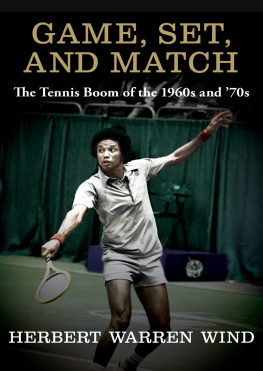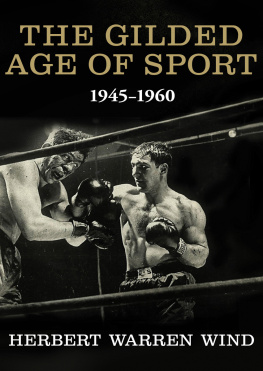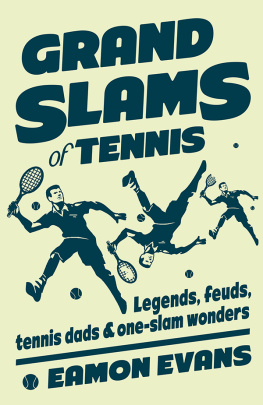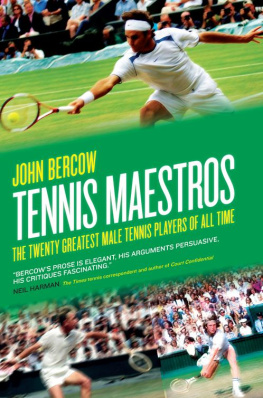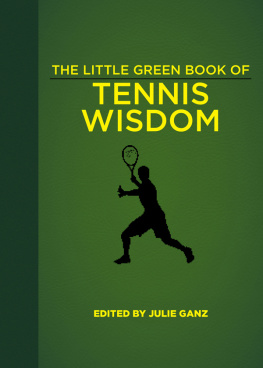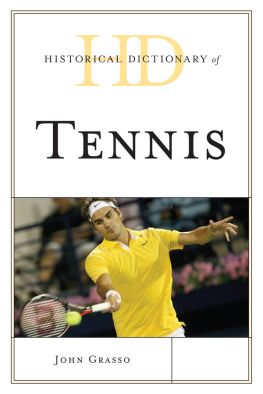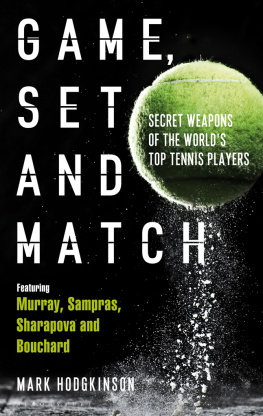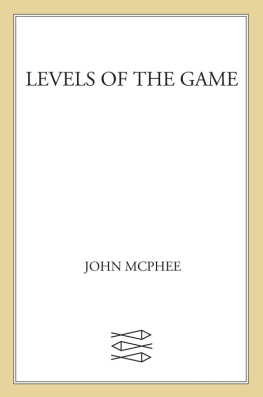Game, Set, and Match
The Tennis Boom of the 1960s and 70s
Herbert Warren Wind

For Al Laney
PREFACE
This book deals primarily with the nineteen-sixties and the nineteen-seventies, a period in which tennis underwent some radical changes. For example, the number of players in the United States increased from about five million to close to twenty million. Not only that, but the converts came from all classes of society and all walks of life. As the number of players grew, so did, among other things, the number of new tennis clubs and public facilities, the quality of instruction, the interest in international tournament tennis and the coverage of it. In fact, the whole position of tennis in American life was drastically altered.
The arrival of open tennis in 1968 played a very important part in the tennis explosion. While this book focuses on the leading players and the outstanding matches during this period of change, it has, I trust, another dimension. There are many flashbacks to the beginnings of the game and to the fascinating champions of earlier eras, such as the Renshaw twins, Hazel Hotchkiss Wightman, Bill Tilden, and the French Musketeers. My hope is that all the separate investigations and glimpses fit together like a rough mosaic and constitute, in effect, an informal history of tennis since the games invention by Major Walter Clopton Wingfield in 1873.
H.W.W.
INTRODUCTION
In 1881, eight years after Major Walter Clopton Wingfield, a retired English cavalry officer, had devised the game of lawn tennis, this country set up its own governing body. It was called the United States National Lawn Tennis Association, and thirty-four clubs were affiliated with it. In 1920, no doubt tired of being accused of tautology, the association decided to become the United States Lawn Tennis Association, or, for short, the U.S.L.T.A. It was the U.S.L.T.A. that initiated the Wightman Cup matches, reprimanded Bill Tilden, mourned when Don Budge turned pro, and so on and so forth down through the years. Indeed, the U.S.L.T.A. made all the decisions, national and international, for American amateur tennis and eventually, in 1968, led us into the brave new world of open tennis.
A few years ago a startling communiqu was released from the U.S.L.T.A.s main office on Forty-second Street, in Manhattan. In the future, we were informed, the U.S.L.T.A. would be the U.S.T.A., inasmuch as it had been decided to change the name of the organization to the United States Tennis Association. This made sense, for our national championships at Forest Hills were no longer played on grass but on a synthetic clay-like surface called Har-Tru. Moreover, while the old clubs, such as West Side, Longwood, Orange, and others, retained some grass courts (the Newport Casino still has nothing but grass courts) the day of grass has passed. There is no surface as conducive to fine tennis as good grass, but there is no surface as frustrating to play on as bad grass, and our grass had gradually deteriorated (due primarily, we have been told, to the increase in industrial pollution) until by the middle nineteen-sixties it could no longer stand up to the day-after-day beating of a week-long or a twelve-day tournament. Even the quality of the grass in Wimbledons Centre Court, which, with rare exceptions, is used only during the fortnight of the championships, isnt what it used to be.
For another thing, after the arrival of open tennis, the television networks offered lucrative contracts for the rights to telecast tournaments. Since the TV show had to go on if it was at all possible, this was another potent reason for our tennis clubs to shift from grass, which drained slowly, to one of the many new composition surfaces, either gritty clay-type courts that drained quickly and dried quickly, or asphalt-type courts which were impervious and needed only to be mopped up here and there after a rain to be fit for play again. So the point was well taken: What with outdoor tennis being played predominantly on the new synthetic surfaces and indoor tennis on a large variety of mats and carpets, the moment had come to dispense with the Lawn in our national governing bodys title.
Tennis, like golf and many other enduring games, was first played in Britain. In tennis case, it was invented in the latter half of the nineteenth century when Britain, and England in particular, was hit by a craze for games that could be played on weekends, girls and boys together, on the spreading lawns of stately country homes. As is typical of the British, they called their lawn tennis association The Lawn Tennis Association. (They still do, as if there were no other.) Why, one asks, when for years and years nearly everyone who has played the game has referred to it simply as tennis, was it necessary to use the word lawn? There was a good reason. In the Middle Ages the game we today call court tennis was established in Europe. (Perhaps the only older game that is still played is polo, which the Persians may have originated four thousand years ago.) Some of the people involved in court tennis have always preferred to call it real tennis or royal tennis, if not court tennis, but for most people it was customary down through the centuries to call it tennis and let it go at that.
Major Wingfield, the founder of modern tennis, was the descendant of a very old English family. According to some sources, there may have been a court-tennis court in the ancestral home, Wingfield Castle, in Suffolk. In the majors day the castle had long since been in ruins, but the majorhe was born in 1833knew about court tennis from childhood and played it frequently. When at the age of forty he returned to Britain after a tour of duty in China, he consciously set out to create a new game that he hoped would catch on with the young men and women, who, as he observed, were exuberant about the new cult of games. Because of his background, he was careful not to call the imaginative adaptation of court tennis he devised just plain tennis. The court-tennis crowd still thought of their game as tennis and alluded to it as such, and they would not have liked the majors chutzpah one bit. Since his game was designed to be played on lawns, Major Wingfield opted for lawn tennis, and, no matter what surface it was played on, lawn tennis it remained throughout the world until just a few years ago. It was only when the U.S.L.T.A. decided that the grass at Forest Hills had seen its best days and when Har-Tru courts were installed in 1975 for our championships that here in America the climate became right to consider officially deleting the lawn from lawn tennis.
Over the last dozen years, tennis has enjoyed an incredible boom the likes of which, to my knowledge, no other game has ever experienced. Something like twenty million Americans now play it. Since one of the chapters in this book describes this phenomenon at length, at this time I wish to discuss only one phase of itthe rather widespread misconception that the boom transformed tennis overnight from a minor into a major sport. Assuredly, many more millions play the game and watch it nowadays, but throughout its lifetime, on certain occasionsand they go back as far as the eighteen-eighties when the Renshaw twins ruled Wimbledontennis has been of major interest to the hard core of informed enthusiasts in this country and sometimes even to the vast uncablestitched public that has always found it hard to distinguish between a rally and a volley. Every now and then, in the natural flow of things, tennis players of exceptional skill and personal appeal have opposed challengers of equal quality, and when these confrontations drew near, American sports fans became involvednot to the degree that they did at the prospect of a turbulent World Series, but, nevertheless, genuinely involved. One such occasion was the match at Cannes in 1926 between Suzanne Lenglen and Helen Willsour Helen. In my hometownBrockton, Massachusetts, which was not a particularly tennis-oriented communityon the eve of that match it seemed that everyone was talking about it, and the next day the wire-service report appeared on the front page of the local newspaper. It was the same, I gather, throughout the country. The general interest was extremely intense also whenever Bill Tilden met one of the French Musketeers in a crucial Davis Cup match. In between these big occasionsalmost invariably they were international clashes in which an American was up against a player of great reputationtennis dropped back and became a minor concern of the average American sports fan. However, it should be noted, in the years before the Second World War professional baseball was the only truly major sport in this country and there was no close second. After baseball, the sport that commanded the most attention at that time was college football. In much the same way that was true of tennis, the other sports were of limited interest until a dynamic personality came along and seized the popular imagination. This was true, for example, of Dempsey and boxing. In Dempseys era there were spirited debates on every veranda or in every den for a week before each of his title fights and for a week after it. The American public, which had historically viewed golf as a rich mens diversionand the rich were welcome to itbegan to follow it when Bobby Jones came along, for they sensed that he was the model American athlete. Accordingly, a big occasion for Jones, such as his extended pursuit of a grand slam of the four major championships in 1930, was a big occasion for them. Not many American sports fans burned with a hard, gem-like flame about track and field, but every four years when the Olympics loomed on the horizon, track and field mattered a lot. And so on. My basic thesis is that it is not entirely right to look upon tennis as being an inconsequential sport in this country until the boom when, thanks in the main to open tennis tournaments and the cornucopia of televised matches which gave it the audience it should have had long before, it jumped over the wall of the lite country club and became the raison dtre for nearly all the members of the new egalitarian tennis club. It had attained this position decades earlier in Britain where, up to a point, golf and tennis have long been national sports. It had become one of the glories of France in the nineteen-twenties because of Suzanne and the capture of the Davis Cup by the Four Musketeers. In Australia, where the workingmans chief relaxation was playing sports, tennis was always important, and in the years following the close of the Second World War when the island continent produced the finest players in the world, it became, even in that country where the average man followed cricket and the various forms of rugby fanatically,
Next page
